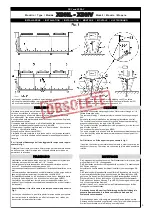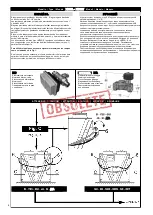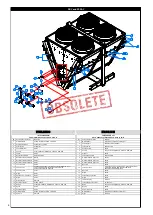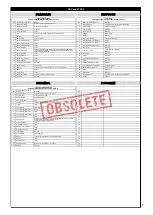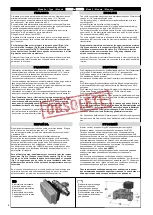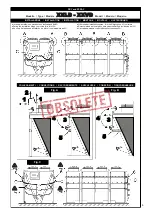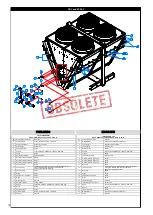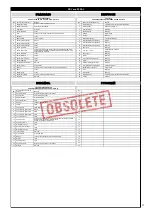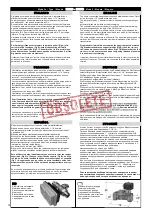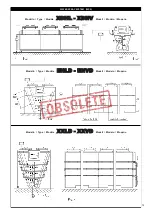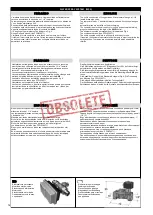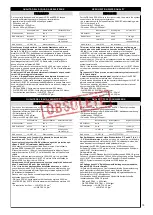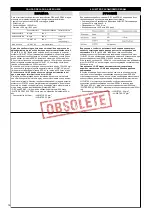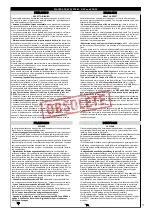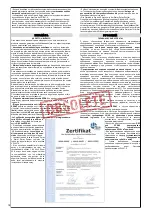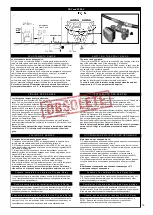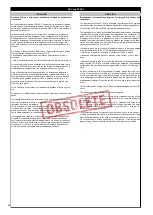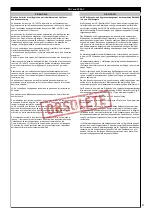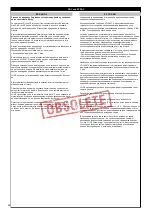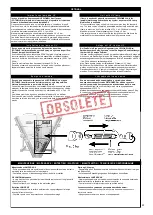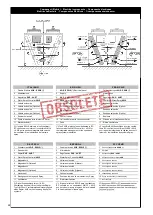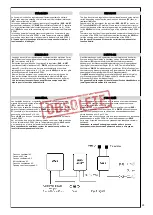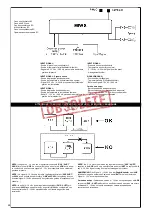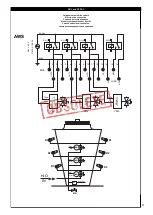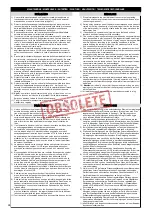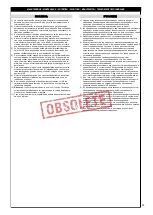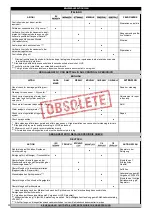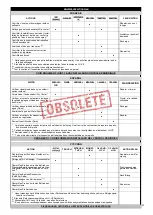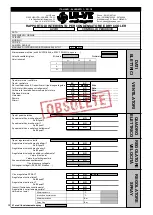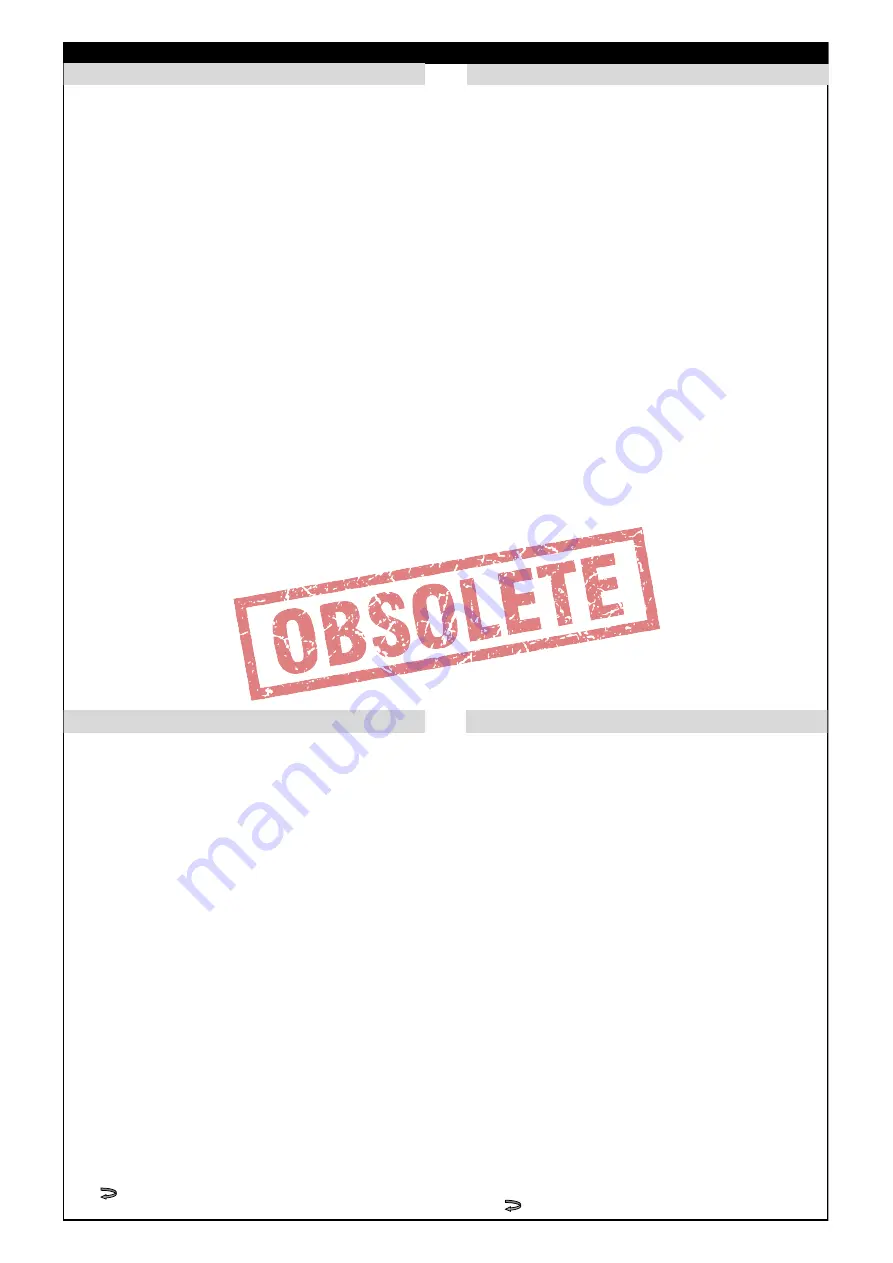
17
WATER SPRAY SYSTEM - DRY and SPRAY
ASPETTO IGIENICO
Grandissima attenzione è stata dedicata a questo aspetto, al fine di offrire
un prodotto in grado di garantire un'assoluta affidabilità. I principali aspetti
che differenziano questo prodotto sono:
•
Assenza di ricircolo dell'acqua nebulizzata;
non è presente alcuna vasca
di raccolta dell'acqua nebulizzata, la quale una volta spruzzata sulle alette
evapora (in larga maggioranza) oppure scende lungo le alette e cade al
suolo, ove sarà smaltita come l’acqua piovana.
• L’acqua spruzzata deve essere trattata e pulita accuratamente. La forma-
zione di depositi e biofilm viene evitata in gran parte, se l’impianto viene
utilizzato secondo le indicazioni del costruttore . Il rischio di una contamina-
zione batterica è quindi ridotto al minimo.
•
Eliminazione del trascinamento di gocce da parte dell'aria
che, dopo aver
attraversato le superfici di scambio, viene espulsa in atmosfera dai ventila-
tori. Per ottenere questo risultato, si è adottata una soluzione che prevede
di iniettare l'acqua, finemente nebulizzata, alla temperatura cui è fornita
dalla rete, a monte delle batterie di scambio termico e di controllare in ogni
condizione operativa che il rapporto fra la portata d'aria e quella dell'acqua
sia sempre molto superiore ai valori per cui possa verificarsi la saturazione.
L‘evoluzione del sistema ha comportato che l’umidità relativa dell’aria
all’uscita dello scambiatore di calore durante il funzionamento normale non
supera il 65%, il che evita quasi completamente la formazione di acqua allo
stato liquido.
Questo valore progettuale è stato misurato in numerosi esperimenti a diver-
se condizioni di funzionamento e non è stata riscontrata alcun deposito di
acqua o formazione di vapore .
•
L'acqua di alimentazione del sistema SPRAY
è acqua potabile trattata e
deve essere conforme alla direttiva sull’acqua potabile. Con il funzionamen-
to come precsritto non c’è da aspettarsi la contaminazione con batteri dan-
nosi per la salute e/o legionella.
•
L’acqua negli ugelli dello spray system
potrebbe riscaldarsi a causa del
calore del sole ad impianto fermo. In queste condizioni esami effettuati
all‘istituto zooprofilattico di Pavia (IT) hanno mostrato che nelle provette
esaminate di acqua addolcita secondo le indicazioni fornite non è stata
riscontrata alcuna proliferazione di legionella pneumophilia.
Sono installate delle elettrovalvole automatiche per lo scarico dell’impianto
• A conferma della qualità e sicurezza il nuovo prodotto
Dry&Spray e Water
Spray System hanno ottenuto il certificato di sicurezza d’igiene del
DFLW
(Associazione tedesca per l’igiene dell’aria e dell‘acqua).
• Qualora ci fossero delle incertezze su eventuali contaminazioni batteriche
presenti nell'acqua potabile di alimentazione del sistema, è possibile fornire
a
richiesta un kit composto da speciali lampade UV
in grado di assicurare la
sterilizzazione dell'acqua stessa.
• Le macchine della serie Dry and Spray e Water Spray System soddisfano
le richieste della linea guida VDI 247 - 2
• Se dovesse essere necessario disinfettare lo spray system e lo scambia-
tore di calore, come disinfettante può essere utilizzato Cillit Allsil Super 25.
In caso di dubbio occorre verificare la compatibilità dei materiali in un punto
nascosto. Dopo la disinfezione occorre sciacquare accuratamente con
acqua lo spray system e l‘unità completa incluso lo scambiatore di calore.
HEALTH ASPECT
Great attention has been paid to this aspect in order to offer a product
which can guarantee absolute reliability. The principle aspects which char-
acterize this product are:
•
Absence of recirculation of the atomized water
; there is no tank to
collect atomized water which, once sprayed onto the fins, evaporates (for
the most part) or rolls down the fins and falls to the ground where it is dis-
posed of as rain water.
• The sprayed water is a carefully treated and purified liquid. The formation
of deposits and biofilm is excluded, subject to compliance with the correct
procedures for cleaning and maintenance of the machines. The risk of
bacterial contamination is therefore reduced to a minimum, provided that
the system is properly operated.
•
Elimination of any air dispersal of water droplets
which, after travers-
ing the surface of the exchanger, are expelled into the atmosphere by the
fans.
To arrive at this result, a solution was adopted which provides for the injec-
tion of finely atomized water, at the temperature of the mains supply, up-
stream of the heat exchanger coils; and to check in every operating condi-
tion that the relationship between the air flow and water flow is always
above the values which could lead to saturation. In fact, the optimization of
the system means that the values of the relative humidity of the air at the
outlet of the coils never exceed 65%. This therefore eliminates any possibil-
ity of the presence of water in liquid form. This projected data has been
verified by numerous experimental tests, conducted under all kinds of con-
ditions. Thus it is physically impossible for any water droplet to be present
in the outlet air flow.
•
The water supplied by the SPRAY system
is drinking water and
therefore by definition cannot be water that has been contaminated by
bacteria (legionella) dangerous to health.
•
The water inside the ramps of the SPRAY
system could, if the system
remains unused, warm up due to the heat of the sun. From the specific
tests carried out by the lstituto
Zooprofilattico di Pavia
(Italy), it clearly
emerges that the softened water treated in accordance with
LU-VE
specifi-
cations does not have any proliferation of legionella pneumophila.
automatic valves are installed on the discharging.
• In confirmation of its quality and safety, the
DRY and SPRAY system has
been awarded the Health Safety Certificate issued by the prestigious
DFLW laboratory in Germany.
•Should there ever be any uncertainty about possible bacterial contamina-
tion of the drinking water supply to the system,
LU-VE can provide upon
request a kit including a special UV lamp
which can guarantee sterili-
zation of the water.
• The machines of the Dry and Spray series meet demands of the VDI 247 -
2 guidelines.
• If it is necessary to disinfect the spray system and the heat exchanger, as
a disinfectant can be used Cillit Allsil Super 25. If in doubt, check the com-
patibility of the materials in a concealed location. After disinfection must be
thoroughly rinsed with water spray system and the complete unit including
the heat exchanger.
I T A L I A N O
E N G L I S H
HYGIENE
La plus grande attention a été apportée à cet aspect pour offrir un produit très
fiable. Ce qui le distingue principalement est :
•
Pas de recyclage de l'eau vaporisée.
Il n'y a pas d'égouttoir pour l'eau vapori-
sée, qui une fois diffusée sur les ailettes s'évapore (en large majorité) ou des-
cend le long des ailettes et tombe au sol, où elle s'écoulera comme de l'eau
pluviale.
• L'eau pulvérisée est un liquide soigneusement traité et purifié. La formation de
dépôts et biofilm est exclue, sous réserve du respect des procédures correctes
pour le nettoyage et l'entretien des machines. Le risque de contamination
bactérienne est donc réduit au minimum, à condition de s’occuper de l’installa-
tion correctement.
•
Elimination de l'émission de gouttelettes par l'air
après avoir traversé les
surfaces d'échange. L'air est expulsé dans l'atmosphère par les ventilateurs
sans aucune gouttelette. Pour obtenir ce résultat; on a adopté une solution qui
prévoit d'injecter de l'eau finement vaporisée à la température qui est fournie
par le réseau en amont des batteries d’échange thermique et de contrôler pour
chaque condition opérationnelle que le rapport entre le débit d’air et celui de
l’eau est toujours bien supérieur aux valeurs pour lesquelles il peut se produire
la saturation. De fait, l’optimalisation du système a amené à des valeurs d’hu-
midité relative de l’air à la sortie des batteries qui ne dépassent jamais 65% , ce
qui élimine donc toute possibilité de présence d’eau à l’état liquide. Cette
donnée de conception a été confirmée par de nombreux tests expérimentaux
effectués dans des conditions opérationnelles les plus diverses possibles. Il est
donc physiquement impossible de trouver la présence de gouttelettes d’eau
dans le flux d’air en sortie des ventilateurs.
•
L'eau d'alimentation du système SPRAY
est potable, et donc par définition,
non contaminée par des batteries (légionnelles…) dangereuses pour la santé.
•
L'eau à l'intérieur des rampes du système SPRAY
peut, si le système est à
l'arrêt, se réchauffer à cause des rayonnements solaires.
Des essais ont été réalisés par l'Institut Zooprofilattico de Pavie (Italie), qui ont
démontré avec certitude que dans l'eau adoucie traitée selon le processus
LU-
VE, il n'y a pas de prolifération de legionella pneumophila
.
Les vannes automatiques sont installées sur l'évacuation.
•
Gage de sa qualité et de sa sécurité, le nouveau produit DRY and SPRAY a
obtenu le Certificat de Sécurité de l'Hygiène délivré par le laboratoire
DFLW en Allemagne.
• ……
F R A N C A I S
D E U T S C H
HYGIENE
Diesem Aspekt wird große Aufmerksamkeit gewidmet, um ein absolut
zuverlässiges Produkt anbieten zu können und unterscheidet sich haup-
tsächlich durch folgende Merkmale:
•
Keine Rezirkulation des Sprühwassers;
es ist kein Sammelbecken für das
Sprühwasser vorhanden, was bei Sprühung auf die Lamellen (zum
Großteil) verdampft oder auf den Boden tropft, wo es wie Regenwasser
entsorgt wird.
• Das versprühte Wasser muss sorgfältig behandelt und gereinigt werden.
Die Bildung von Ablagerungen und Biofilm wird weitestgehend vermieden,
sofern die Anlage bestimmungsgemäß nud nach Herstellervorgaben be-
trieben wird.
•
Anlagenbetrieb ohne Schwadenbildung in der Luft
, die nach den Durch-
gang durch die Austauscherfläche, von den Ventilatoren in die Atmosphäre
ausgestossen wird. Um dieses Ergebnis zu erzielen, wird bei allen Be-
triebsbedingungen, das Verhältnis zwischen Luft- und Wassermenge so
geregelt, dass keine Ubersättigung stattfinden kann. Die Optimierung des
Systems hat dazu geführt, dass die relative Luftfeuchtigkeit am Wärme-
tauscheraustritt im Normalbetrieb nicht über 65% liegt, wodurch das Austra-
gen von Wasser in flüssigem Zustand nahezu vollständig vermieden wird.
Dieser Projektwert wurde in zahlreichen Experimenten unter unterschie-
dlichsten Betriebsbedingungen gemessen und in den Untersuchungen
wurde kein Wasseraustrag bzw. Schwaden festgestellt .
• Das zu verwendende Speisewasser ist aufbereitetes Trinkwasser und soll
den Anforderungen nach Trinkwasserverordnung genügen. Bei bestim-
mungsgemäßem Betrieb ist eine Kontamination mit gesundheitsschädli-
chen Bakterien bzw. Legionellen nicht zu erwarten .
• Das Wasser in den Sprühlanzen des Spraysystems könnte sich bei Still-
stand durch Sonneneinstrahlung erwärmen. Untersuchungen am Istituto
Zooprofilattico die Pavia (IT) haben ergeben, daß bei den untersuchten
Proben im enthärteten, nach LU-VE Vorgaben aufbereitetem Wasser keine
Vermehrung von Legionella Pneumophilia nachgewiesen werden konnte .
Automatische Ventile werden auf der Entladungs installiert.
• Zur Bestätigung der Qualität und Sicherheit hat das neueProdukt
Dry+Spray sowie Water Spray System das Zertifikat zur Hygienesicherheit
vom DFLW ( Deutscher Fachverband für Luft- und Wasserhygiene e.V. )
erhalten .
• …...
Summary of Contents for EHLD
Page 47: ...47 NOTE NOTES ...

